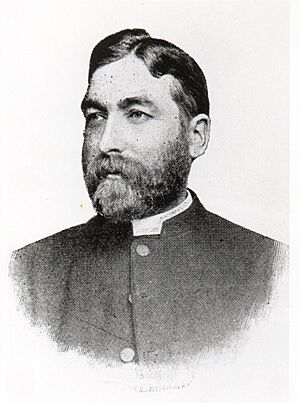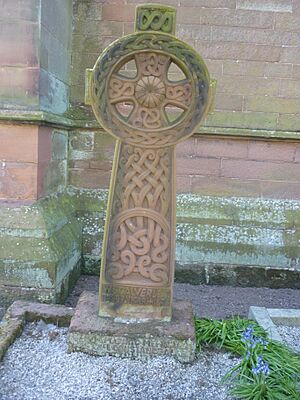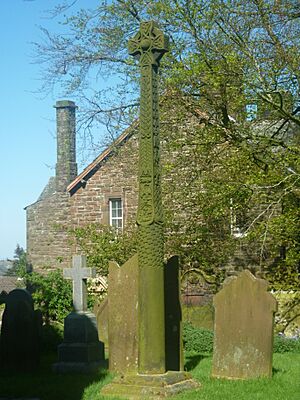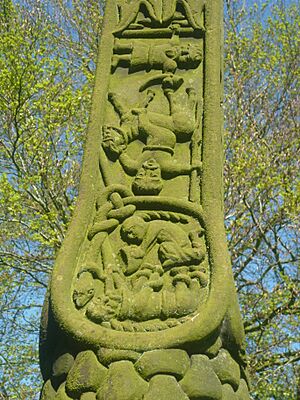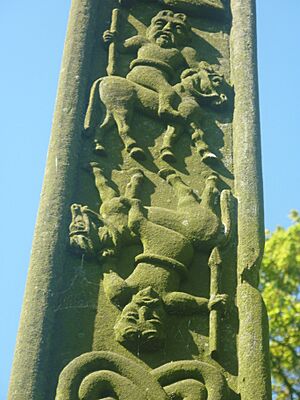William Slater Calverley facts for kids
The Rev. William Slater Calverley (1847–1898) was a quiet English vicar who became an amazing amateur antiquarian. An antiquarian is someone who studies old things. He loved to study old carvings and sculptures found in churchyards in Cumberland.
Calverley made detailed drawings of these old finds. He talked with important experts and shared his own ideas. He even made a life-sized copy of the famous Gosforth Cross. This copy can still be seen today in Aspatria churchyard.
Contents
About William Calverley
His Early Life and Education
William Slater Calverley was born in Kibworth, Leicestershire, in 1847. He went to New College, Oxford, but left to study art. He attended the South Kensington School of Art. People said he was very talented and could have won a gold medal, but he got sick. His art skills helped him a lot later in life.
Even with his artistic talent, he chose to join the church. He became a deacon in 1872 in Carlisle. A deacon is a church official who helps the priest. Later, he became a curate in Eskdale parish. A curate is a priest's assistant. In 1873, he became a priest and moved to Maryport. In 1874, he went to Dearham, where he was a curate for three years and then the vicar for eight years.
While he was at Dearham, he helped fix up the church. He also made the vicarage (the vicar's house) and churchyard bigger. He even helped start a new church in Ellenborough. In 1885, he became the vicar of St. Kentigern's Church, Aspatria. He helped get new bells for this church.
His Love for Ancient History
Calverley became very interested in ancient history during the church repairs at Dearham. These repairs uncovered old artworks. By studying pre-Norman stones and objects, he became a leading expert in old things.
He found several old sculptures from before the Normans arrived in England. He then contacted important experts. He worked closely with Professor George Stephens from Copenhagen University. Stephens even included Calverley's discoveries in his book, Old Northern Runic Monuments.
Working with Stephens encouraged Calverley to learn even more. In 1883, he announced a big discovery. He had read Edda myths on the Christian cross at Gosforth, in West Cumberland. This news was very exciting! Before this, experts thought Christian monuments only showed Christian stories. Calverley showed that English relics could also include old 'Pagan' stories. His ideas were proven right when other experts, like Rev. G. F. Browne, found similar connections.
In 1891, Calverley explained the Völsung myth on a cross at Halton. He gave talks about his findings to different groups. These included the Lancaster Philosophical Society and the Royal Archaeological Institute in Edinburgh.
Calverley's Work at Aspatria
As vicar at Aspatria, Calverley started to study the old objects there. He made detailed drawings of the 'Standing Cross'. This cross was in the churchyard. He compared its carvings to other items in the area. He also studied the Saxon hogbacks (stone tombs shaped like pigs), swastikas, and spiral carvings. He started to figure out how old and important the church site was.
He realized how valuable these old items were. So, he moved them into the church's vestry (a room for church robes and items) to keep them safe. His ideas about these items are still respected today.
However, he became most famous for understanding the spiral carvings on the Gosforth Cross. He didn't just sketch them. Calverley decided to make an exact, life-sized copy of the cross. He wanted to understand its secrets better.
Aspatria has a lot of red freestone (a type of stone). He got a large piece of rock from local quarries. It was 2 feet wide, 2 feet thick, and 16 feet long. With help from a retired master mason, he carved the cross. He copied every detail of the carvings. This replica cross now stands in the east end of Aspatria churchyard. It is just a few feet from where Calverley is buried.
When Stephens visited the Gosforth Cross, he called it "one of the costliest olden Roods in Europe." He said it was unique and probably from the 7th century. Calverley believed it was a Christian monument, not a pagan pillar. He described it as "an elaborately carved Christian cross."
His Academic Achievements
Calverley was chosen as a Fellow of the Society of Antiquaries of London (F.S.A.) in 1885. This is a special honor for people who study old things. He worked as the Cumberland secretary, reporting new discoveries. He was also a member of the Royal Archaeological Institute. He was also a Fellow of the Royal Historical Society.
He gave many talks about his findings to different groups. He was also very involved in digging up the Hardknott Roman Fort in South Cumberland. He joined a group of experts who looked after the exploration of Hadrian's Wall in northern England.
Calverley died before his most important book was published. It was called Notes on the Early Sculptured Crosses, Shrines and Monuments in the Present Diocese of Carlisle. It was published in 1898 with W. G. Collingwood as the editor.
His Community Work
Calverley cared a lot about Aspatria. He was a member of the Local Board. Later, he joined the Aspatria Urban District Council. He also served on the Aspatria and Brayton School Board.
His Writings and Discoveries
Calverley wrote many important papers about his discoveries. Most of these were for the Cumberland and Westmoreland Antiquarian and Archaeological Society. They were printed in their Transactions (their official reports).
Some of his key papers included:
- Notes on the Sculptured Stones at Dearham Church (1880).
- Illustrations of Teutonic Mythology from early Christian Monuments at Brigham and Dearham (1881).
- The Sculptured Cross at Gosforth, West Cumberland (1883).
- Early Sculptured Cross Shaft at Dearham Church, Cumberland (1883).
- Sculptured Stone at Isel Church, Cumberland, showing the 'Swastika' and other symbols (1885).
- Notes on some old Tombstones at Aspatria, Lowther, Cross-Canonby, and Plumbland (1887).
- Pre-Norman Cross fragments at Aspatria, Workington, and other places (1889).
- The Dacre Stone (1890).
- Bewcastle Cross (1891).
- The Roman Fort at Hardknott (1893 and 1895).
- Shrine-shaped or Coped Tombstone at Gosforth, Cumberland (1897).
He also wrote two papers for the Archaeological Institute about the Gosforth Cross. These were published in the Archaeological Journal.


